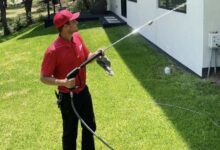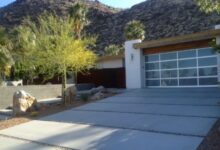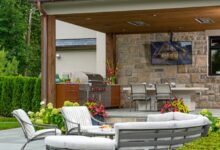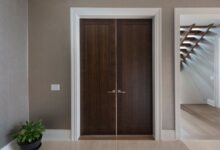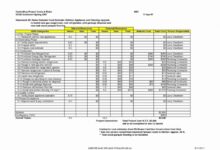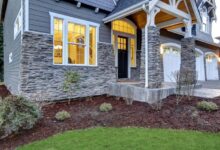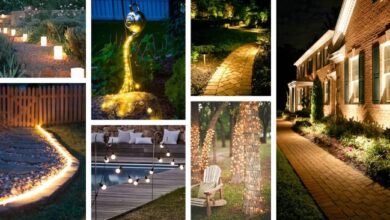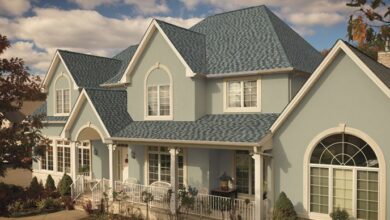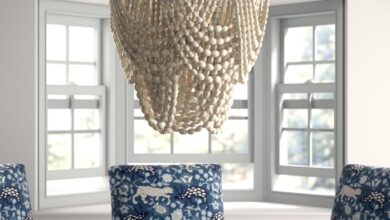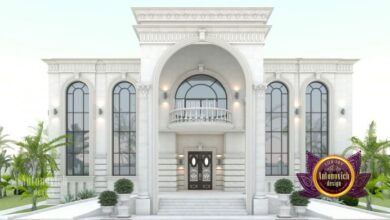Energy-efficient home exterior solutions
Energy-efficient home exterior solutions offer a compelling pathway to reduce energy consumption and lower utility bills. By strategically improving the building envelope – encompassing walls, windows, roof, and landscaping – homeowners can significantly enhance their home’s thermal performance, creating a more comfortable and sustainable living environment. This exploration delves into practical strategies and innovative technologies that transform a house into an energy-conscious haven.
This guide examines various aspects of exterior home improvements, from selecting appropriate insulation materials and high-performance windows to optimizing roofing systems and employing strategic landscaping. We will explore the cost-effectiveness of different options, detailing installation processes and highlighting the long-term benefits of investing in energy efficiency. The goal is to equip homeowners with the knowledge necessary to make informed decisions, ultimately leading to reduced energy costs and a smaller environmental footprint.
Insulation Materials and Techniques
Effective exterior wall insulation is crucial for energy-efficient homes, significantly reducing heating and cooling costs while enhancing comfort. The choice of insulation material and installation method significantly impacts the overall thermal performance and longevity of the building envelope. This section details various insulation options and their respective installation processes.
Insulation Material Thermal Performance
Several materials offer excellent thermal performance for exterior walls. Fiberglass, cellulose, and spray foam are among the most common choices, each possessing unique characteristics influencing their R-value (a measure of thermal resistance) and cost-effectiveness. Higher R-values indicate better insulation.
| Insulation Material | Typical R-Value per Inch | Cost (per unit) | Cost-Effectiveness Notes |
|---|---|---|---|
| Fiberglass Batts/Rolls | R-3 to R-6 | Low to Moderate | Readily available, easy to install, but may settle over time, reducing effectiveness. |
| Cellulose Loose-Fill | R-3.1 to R-3.8 per inch | Moderate | Excellent air sealing properties, good moisture resistance, recycled content. Requires specialized equipment for installation. |
| Spray Foam (Open-cell) | R-3.6 to R-4 per inch | Moderate to High | Excellent air and moisture sealing, high R-value, but requires professional installation. |
| Spray Foam (Closed-cell) | R-6 to R-7 per inch | High | Superior air and moisture barrier, highest R-value, but expensive and requires specialized equipment and professional installation. |
Exterior Wall Insulation Methods
The method of applying insulation significantly affects energy efficiency. Different approaches offer varying benefits and drawbacks.
The following are descriptions of common exterior wall insulation methods:
- Continuous Insulation: This method involves installing a continuous layer of insulation over the entire exterior wall, eliminating thermal bridging (heat transfer through structural elements).
- Advantages: Superior thermal performance, reduced energy loss, improved comfort.
- Disadvantages: Can be more expensive and complex to install than other methods, may require more specialized expertise.
- Exterior Insulation and Finish Systems (EIFS): This system combines insulation with a protective outer layer, often stucco or a similar finish.
- Advantages: Improved aesthetics, good protection from the elements, can improve the building’s overall appearance.
- Disadvantages: Can be more expensive than other methods, proper installation is crucial to prevent moisture problems.
- Exterior Insulated Wall Systems (EIW): This system is designed to provide a continuous layer of insulation from the exterior to increase energy efficiency.
- Advantages: Improved energy efficiency, reduced heat transfer, good protection from the elements.
- Disadvantages: Can be more expensive than other methods, installation requires specific expertise.
Installation Process for Fiberglass Batts and Spray Foam
The installation process varies significantly depending on the chosen insulation material. Here are examples for two common types:
Fiberglass Batt Installation:
Fiberglass batts are relatively easy to install, requiring minimal specialized tools. The process typically involves cutting the batts to fit between wall studs, ensuring a snug fit to minimize air gaps. Safety precautions include wearing gloves, eye protection, and a respirator to avoid skin irritation and inhalation of fibers.
Spray Foam Installation:
Spray foam installation requires specialized equipment and expertise. The process involves spraying the foam into wall cavities, completely filling the space to create a continuous air barrier. Safety precautions are paramount due to the use of chemicals. Professional installers must follow strict safety protocols, including wearing appropriate personal protective equipment (PPE) such as respirators, protective clothing, and eye protection.
The area must be well-ventilated to prevent hazardous gas build-up. Improper application can lead to health hazards and building damage.
Window and Door Selection
Choosing the right windows and doors is crucial for maximizing your home’s energy efficiency. These components represent significant areas of heat loss and gain, directly impacting your heating and cooling costs. Careful selection of materials and proper installation are key to minimizing energy waste.
Comparison of Window Types and Frame Materials
The energy efficiency of windows and doors depends on several factors, primarily the type of glazing, the presence of low-E coatings, and the material of the frame. The table below summarizes the relative performance of common options.
| Feature | Double-Pane | Triple-Pane | Low-E Coating | Frame Material |
|---|---|---|---|---|
| Energy Efficiency | Good | Excellent | Significantly Improves All | Fiberglass > Wood > Vinyl |
| Insulation Value (U-factor) | 0.25-0.35 BTU/(hr·ft²·°F) | 0.15-0.25 BTU/(hr·ft²·°F) | Reduces U-factor by 0.1-0.2 | Varies depending on construction and thickness |
| Cost | Moderate | High | Adds to cost of double or triple pane | Fiberglass > Wood > Vinyl |
| Maintenance | Low | Low | None required | Wood (High) > Fiberglass (Moderate) > Vinyl (Low) |
| Durability | Moderate | High | Increases durability of glass | Fiberglass > Wood > Vinyl |
Note: U-factor is a measure of how well a window resists heat transfer. Lower U-factors indicate better insulation. These values are approximate and can vary based on specific product specifications.
Importance of Proper Window and Door Sealing and Weatherstripping
Air leaks around windows and doors are a major source of energy loss. Effective sealing and weatherstripping significantly reduce drafts and improve comfort. This reduces the load on your HVAC system and lowers your energy bills. For example, a poorly sealed window can lead to a significant increase in heating costs during winter and cooling costs during summer.
Energy-efficient home exterior solutions are crucial for reducing energy consumption. A key component of this is thoughtful exterior lighting, and integrating smart technology can significantly improve efficiency. For instance, consider incorporating Smart home lighting systems to automate your outdoor lighting, optimizing energy use based on occupancy and ambient light levels. This seamless integration enhances both energy savings and security, complementing your overall energy-efficient home exterior strategy.
A home energy audit can often identify these areas of leakage.
Step-by-Step Guide to Sealing Gaps and Cracks
1. Identify Leaks
Use a smoke stick or incense to visualize air movement around windows and doors.
2. Clean Surfaces
Remove any loose paint, dirt, or debris from the areas to be sealed.
Energy-efficient home exterior solutions are increasingly important for reducing energy consumption. One often-overlooked aspect is the aesthetic contribution; for instance, incorporating beautiful, handcrafted elements can enhance curb appeal while maintaining efficiency. You might consider using unique, custom-made tiles from a source like Handmade ceramics for features such as decorative wall accents or even energy-efficient window surrounds, adding a personal touch while boosting your home’s overall energy performance.
3. Apply Weatherstripping
Choose appropriate weatherstripping based on the gap size (foam tape, felt, rubber). Apply according to the manufacturer’s instructions, ensuring a tight seal.
4. Caulk Gaps
Use exterior-grade caulk to fill larger gaps and cracks. Apply in a smooth, continuous bead, ensuring good adhesion.
5. Inspect Regularly
Improving your home’s energy efficiency starts with the exterior. Consider things like updated insulation and high-performance windows to reduce energy loss. While you’re focusing on the outside, you might also find inspiration for your autumnal curb appeal by checking out some fantastic ideas for Fall home decorating ideas to complement your energy-saving upgrades. Ultimately, a well-insulated and aesthetically pleasing exterior will save you money and enhance your home’s overall value.
Periodically check for any deterioration or damage to weatherstripping and caulk, and repair as needed.
Energy-efficient home exterior solutions, such as high-performance windows and improved insulation, can significantly reduce energy consumption. However, maximizing these benefits often requires careful consideration of storage, especially in smaller homes. For clever ideas on organizing and storing items efficiently, check out these helpful resources on Small space storage solutions to free up space for energy-saving upgrades.
Ultimately, both efficient storage and exterior solutions contribute to a more sustainable and comfortable living environment.
Hypothetical Energy-Efficient Window and Door System for a Cold and Snowy Climate
For a cold and snowy climate, such as those found in the Northeastern United States or Canada, a system prioritizing maximum insulation and durability is essential. This would involve:* Windows: Triple-pane windows with low-E coatings and argon gas fill. The low-E coating reflects radiant heat back into the home, while the argon gas further improves insulation. Fiberglass frames would be preferred due to their superior insulation and durability compared to vinyl or wood.
Doors
Solid-core exterior doors with a high R-value (a measure of thermal resistance). A weather stripping system with multiple seals, including a door sweep, would be crucial to minimize air infiltration. Fiberglass or well-maintained wood doors would be suitable choices. The use of a storm door adds an additional layer of protection and further reduces heat loss.
This system will minimize heat loss during the long, cold winters and reduce reliance on the heating system. The upfront cost will be higher, but the long-term energy savings will offset this initial investment.
Roofing and Ventilation
Proper roofing and ventilation are crucial components of an energy-efficient home exterior. These elements significantly impact both the heating and cooling loads, directly affecting your energy consumption and overall comfort. By carefully selecting roofing materials and implementing effective ventilation strategies, you can substantially reduce your home’s energy footprint.Roof color and reflectivity, also known as albedo, play a significant role in regulating the temperature of your home.
Darker colored roofs absorb more solar radiation, leading to increased heat gain in summer and higher cooling costs. Conversely, lighter colored roofs reflect more sunlight, minimizing heat absorption and lowering cooling demands.
Roof Color and Albedo’s Impact on Energy Consumption
The albedo of a roofing material represents its ability to reflect solar radiation. A high albedo means a greater percentage of sunlight is reflected, resulting in lower surface temperatures. Conversely, a low albedo indicates that more sunlight is absorbed, leading to higher surface temperatures. This directly translates to energy savings, particularly in warmer climates. For instance, a white roof can reflect up to 80% of solar radiation, significantly reducing the heat transferred to the attic and subsequently the interior of the house compared to a dark-colored roof which may only reflect 10-20%.
High-albedo roofing materials include white or light-colored tiles, cool roofing membranes, and reflective coatings applied to existing roofs. These materials can lead to substantial reductions in cooling energy consumption, potentially saving hundreds of dollars annually depending on climate and roof size.
Attic Ventilation Strategies and Their Impact on Energy Efficiency
Proper attic ventilation is essential for regulating attic temperature and preventing the build-up of moisture. In summer, adequate ventilation helps to expel hot air trapped in the attic, reducing heat transfer to the living spaces below. In winter, ventilation helps to remove moisture that could lead to condensation and ice dam formation, while also preventing excessive heat loss.
Inefficient attic ventilation can lead to significant energy waste and potential structural damage.A diagram illustrating effective attic ventilation typically shows a combination of intake vents (low in the soffit) and exhaust vents (high in the gable ends or ridge). The intake vents allow cool, outside air to enter the attic, while the exhaust vents expel the hot, moist air.
This creates a natural convection current, drawing hot air out and pulling cool air in. A well-ventilated attic should have a balanced airflow, ensuring sufficient intake and exhaust capacity to maintain a consistent temperature. The ratio of intake to exhaust ventilation should be carefully considered, and often depends on the attic’s size and shape, ensuring sufficient air movement without creating excessive drafts.
Properly sized and strategically placed vents are crucial for maximizing the effectiveness of attic ventilation.
Best Practices for Installing Energy-Efficient Roofing Materials
Proper installation of roofing materials is crucial for maximizing their energy-saving potential. Attention to detail during installation significantly reduces heat transfer and improves the overall performance of the roofing system. This includes ensuring proper underlayment, sealing all seams and gaps to prevent air leakage, and using appropriate flashing around chimneys and vents. Furthermore, the installation of insulation in the attic, under the roof sheathing, is essential to further minimize heat transfer and improve overall energy efficiency.
Careful attention to insulation continuity around penetrations like chimneys and vents is equally important to prevent thermal bridging, ensuring consistent insulation performance. A properly installed, energy-efficient roofing system contributes significantly to a home’s overall energy performance and longevity.
Exterior Finishes and Coatings: Energy-efficient Home Exterior Solutions
Choosing the right exterior finishes and coatings is crucial for energy efficiency. The materials you select directly impact your home’s ability to resist heat gain in summer and heat loss in winter, significantly affecting your energy bills and overall comfort. The reflective properties of certain materials and coatings play a vital role in minimizing the impact of solar radiation.
Investing in energy-efficient home exterior solutions, such as high-performance windows and proper insulation, significantly reduces energy consumption. This, in turn, allows you to allocate more of your budget towards creating a truly inviting atmosphere inside, perhaps focusing on elements found in a guide like Cozy living room essentials. Ultimately, a comfortable and energy-efficient home provides both financial and environmental benefits, beginning with well-considered exterior improvements.
This section will explore the energy-saving properties of various exterior cladding materials and delve into the benefits of reflective paints and coatings. We’ll also provide a simplified method for estimating potential energy savings achieved through the implementation of these reflective solutions.
Comparison of Exterior Cladding Materials
The choice of exterior cladding significantly influences a home’s energy performance. Different materials offer varying levels of insulation and resistance to heat transfer.
Below is a comparison of four common cladding options: wood siding, vinyl siding, brick, and fiber cement.
- Wood Siding:
- Pros: Aesthetically pleasing, naturally insulating (depending on wood type and thickness), can be treated for longevity.
- Cons: Requires regular maintenance (painting, staining), susceptible to rot, insect damage, and fire, relatively high cost.
- Vinyl Siding:
- Pros: Low maintenance, relatively inexpensive, durable, comes in various colors and styles.
- Cons: Can fade over time, less durable than other options in extreme weather, may not be as aesthetically pleasing as natural materials, can warp in extreme heat.
- Brick:
- Pros: Durable, fire-resistant, excellent thermal mass (helps regulate indoor temperatures), low maintenance.
- Cons: High initial cost, can be heavy, less versatile in terms of design and color options than other materials.
- Fiber Cement Siding:
- Pros: Durable, fire-resistant, low maintenance, resists rot and insects, can mimic the look of wood.
- Cons: Higher cost than vinyl, can be brittle and prone to cracking if not installed properly, heavier than vinyl siding.
Reflective Paints and Coatings
Reflective paints and coatings, often containing pigments like titanium dioxide or aluminum, significantly reduce solar heat gain by reflecting a substantial portion of incoming solar radiation. This reduces the amount of heat transferred into the building, lowering cooling loads and energy consumption.
These coatings are typically applied by brush, roller, or spray, and their longevity varies depending on the specific product and environmental conditions. High-quality reflective coatings can last for 10-15 years or more, while some lower-quality options may require reapplication every few years. Proper surface preparation before application is essential for optimal adhesion and longevity.
Calculating Potential Energy Savings
Estimating the energy savings from reflective coatings requires considering several factors, including the surface area, solar radiation intensity, coating reflectivity, and existing insulation levels. A simplified calculation can provide a reasonable estimate.
Let’s assume a house with a south-facing wall of 200 square feet. The average solar radiation in a particular region is 300 BTU/sq ft/day during peak summer months. A standard white paint reflects about 20% of solar radiation, while a high-performance reflective coating might reflect 80%. The difference in reflected energy is 60% (80%
-20%).
The potential energy savings for this wall can be estimated as follows:
Energy Savings = Surface Area x Solar Radiation x Reflectivity Difference
Energy Savings = 200 sq ft x 300 BTU/sq ft/day x 0.60 = 36,000 BTU/day
Converting BTU to kilowatt-hours (kWh) (assuming 1 kWh ≈ 3412 BTU), the daily savings is approximately 10.5 kWh. Annual savings (assuming 90 peak summer days) would be roughly 945 kWh. At an average electricity cost of $0.15/kWh, the annual cost savings would be approximately $141.75. This is a simplified calculation and actual savings will vary based on the specific factors mentioned above.
Further analysis should include factors like climate, building orientation, and the impact on heating energy in the winter.
Landscaping and Shading

Source: co.uk
Strategic landscaping plays a crucial role in enhancing the energy efficiency of a home. By carefully selecting and placing trees, shrubs, and other vegetation, homeowners can significantly reduce energy consumption throughout the year. This is achieved primarily through shading, which reduces the amount of solar heat gain in the summer, and windbreaks, which minimize heat loss in the winter.
The right landscaping can also improve the overall aesthetic appeal of a property.
Effective landscaping techniques leverage natural elements to passively regulate the home’s temperature. Deciduous trees, for instance, provide shade during the hot summer months while allowing sunlight to penetrate in the winter when warmth is needed. Evergreen shrubs can act as windbreaks, reducing the amount of cold air that reaches the house in winter and protecting it from harsh winds.
The placement of these elements is key; strategically positioning plants to shade south-facing walls in the Northern Hemisphere (or north-facing walls in the Southern Hemisphere) is particularly effective.
Effective Landscaping Techniques for Energy Efficiency, Energy-efficient home exterior solutions
Consider these examples of effective landscaping techniques, illustrating how plant placement can significantly impact energy consumption.
Image 1: Deciduous Trees for Summer Shade – This image depicts a house with several mature deciduous trees strategically planted to the south and west. The lush canopies cast significant shade on the house’s walls during the summer, preventing solar heat gain. In winter, when the leaves have fallen, the sunlight penetrates, providing passive solar heating. The trees are spaced sufficiently to allow sunlight penetration in winter, while providing dense shade in summer.
The species of tree is chosen for its ability to provide dense foliage in summer and to lose its leaves in winter. This demonstrates the principle of seasonal shading.
Image 2: Evergreen Shrubs as Windbreaks – This image shows a row of densely planted evergreen shrubs along the north side of the house, acting as a natural windbreak. The shrubs are tall enough to significantly reduce the impact of cold winter winds on the house’s exterior walls, minimizing heat loss. The dense foliage creates a barrier that slows down the wind, preventing it from directly impacting the house.
The evergreen nature of the shrubs ensures year-round protection from wind.
Image 3: Climbing Vines on South-Facing Walls – This image displays a south-facing wall covered with a climbing vine. The vine provides shade during the summer months, significantly reducing solar heat gain on the wall. In winter, the leaves of the vine die back, allowing sunlight to reach the wall and contribute to passive solar heating. The vine is chosen for its rapid growth and ability to cover a large area quickly.
This showcases a cost-effective way to reduce solar heat gain.
Types of Shading Devices
Various shading devices can further enhance energy efficiency. Each has its own set of advantages and disadvantages depending on the specific climate and architectural design.
- Awning:
- Pros: Relatively inexpensive, easy to install, retractable for adjustable shade.
- Cons: Can be damaged by strong winds, may not provide sufficient shade for large windows.
- Overhangs:
- Pros: Effective in reducing solar heat gain, integrated into the building design, durable.
- Cons: Requires careful design and planning during construction, can limit natural light in winter.
- Pergolas:
- Pros: Provides shade and a visually appealing outdoor space, can support climbing plants for added shade.
- Cons: More expensive than awnings, requires more space, may not be suitable for all climates.
Conceptual Landscape Plan
For a house situated in a hot, sunny climate with a south-facing orientation (Northern Hemisphere), a landscape plan might incorporate the following: Deciduous trees planted to the south and west of the house to provide shade during summer. Evergreen shrubs planted along the north side to act as a windbreak. A pergola could be added to the south-facing patio to provide shade for outdoor living areas.
Climbing vines could be planted on the south-facing walls to further reduce solar heat gain. This design combines passive shading strategies with additional shading devices to create an energy-efficient and aesthetically pleasing outdoor environment. The specific plant species would be selected based on the local climate and soil conditions. This design minimizes solar heat gain in summer and allows for maximum sunlight penetration in winter, thereby reducing heating and cooling loads.
Closure
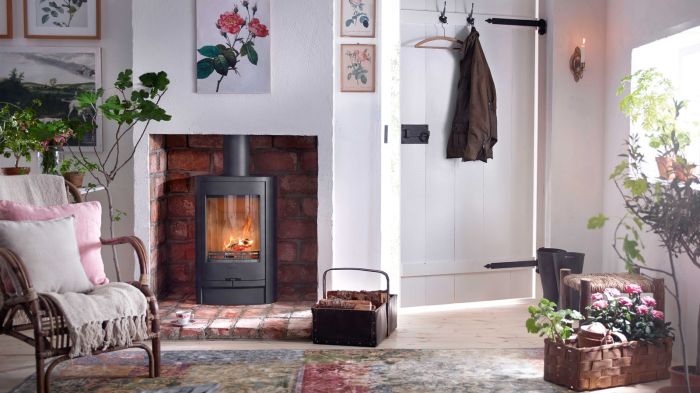
Source: futurecdn.net
Implementing energy-efficient home exterior solutions is an investment that yields substantial returns in both financial savings and environmental responsibility. From the enhanced comfort of a well-insulated home to the reduced carbon emissions associated with lower energy consumption, the benefits are far-reaching. By carefully considering the options presented, homeowners can create a home that is not only more energy-efficient but also more aesthetically pleasing and comfortable.
The path to a sustainable future begins with informed choices, and this guide serves as a valuable resource for homeowners seeking to embark on this journey.
Helpful Answers
What are the potential drawbacks of using spray foam insulation?
While effective, spray foam can be more expensive than other insulation types. It also requires professional installation and can be challenging to repair if damaged.
How often should I inspect and maintain my weatherstripping?
Annual inspection is recommended, particularly before winter. Replace damaged or worn weatherstripping as needed.
Can I install energy-efficient roofing materials myself?
While some simpler materials might be DIY-friendly, complex roofing projects often require professional installation to ensure proper performance and safety.
What is the lifespan of reflective paints and coatings?
Lifespan varies depending on the product and environmental factors, but generally ranges from 5 to 15 years.
How do I determine the best landscaping approach for my home?
Consider your home’s orientation, prevailing winds, and local climate. Consult a landscape professional for personalized advice.
